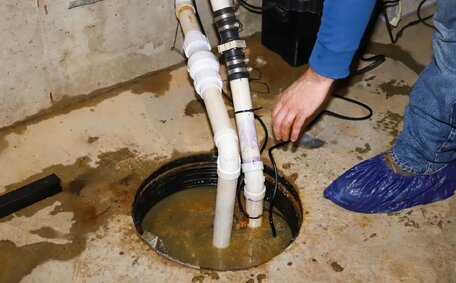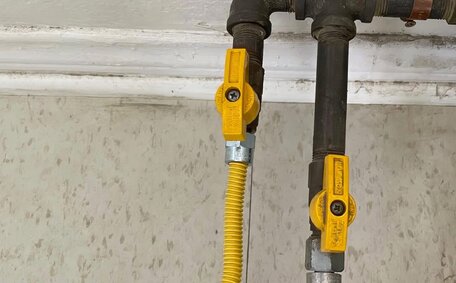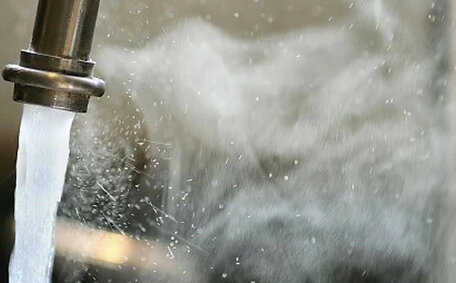Locating and Accessing the Water Heater Thermostat
The location of your water heater’s thermostat varies based on the system type. Follow these guidelines to access the thermostat on prevalent water heater models:
Electric Water Heaters
Typically, electric water heaters feature thermostats and temperature controls on their top or sides. You’ll usually find it concealed behind a small access panel. Always switch off the power at the circuit breaker before opening the panel, to ensure safety.
Gas Water Heaters
Gas water heaters commonly place the thermostat near the tank’s base. You can recognize it externally by the temperature dial or lever used for heat regulation. Ensure both the pilot light and gas supply are switched off before you approach the thermostat.
Tankless/On-Demand Water Heaters
Tankless heaters and heat pump services feature an external electronic panel to manage water temperature. Through this panel, you can digitally set the water temperature for consistent heat output. For safety, cut the power and gas supply before removing any panels to avoid burns.
Recommended Temperature Settings
Recommended Hot Water Temperature
A recommended hot water heater temperature for most households lies between 49 to 60 degrees Celsius. This balances reducing energy use while still allowing for the effective sterilisation of your hot water storage tank and avoidance of scalding and burns.
Benefits of the 120 F standard include:
- Reduced energy bills - A heater set near 50 degrees Celsius can lower energy consumption, since water heaters contribute to approximately 18% of household energy use.
- Safety - A water heater set at a higher temperature than 120 degrees increases the risk of scalds and burns.
- Bacteria control - Temperatures of 120 degrees effectively kill Legionella bacteria.
Temperatures set too hot use more energy and increase safety hazards, especially for children and elderly. Customers express satisfaction with their water temperatures maintained around 120 degrees, which effectively prevents bacterial growth.
Always check out manufacturer guidelines to learn more about changing your water heater temperature. Consider installing thermostatic mixing valves for added safety, especially in households with young children.
Adjusting the Thermostat Up or Down
Discovering how adjust your hot water systems’ temperature is an easy process, but it’s essential to do it carefully by following the manufacturer’s guidelines. Here are the basic steps for common water heater types:
Locate the thermostat controls on your gas water heater to adjust the temperature according to your needs, typically between 45°C and 74°C. Ensure that the power is off at the circuit breaker before opening any panels.
Find the lever arm or temperature dial on your gas heater to adjust the temperature water of the hot water. Gradually adjust the hot water temperature within the unit’s safe range to achieve the desired setting. Shut off gas supply valve before accessing controls.
Tankless/On-Demand Heaters
Utilize the digital temperature control panel to select your desired output temperature and minimize scalding risks. Continuous flow systems typically allow water temperature adjustment from 37°C to 48°C or higher. Ensure the temperature your hot water is properly set by shutting off power and gas before removing any covers.
Regardless of water heater type, adjust in small increments and check water temp at taps to confirm new setting. Consider installing a tempering valve for added safety, especially in households with children or elderly.
Improving Efficiency with Lower Temperatures
The U.S.
Department of Energy recommends setting water heaters to 120°F to balance bacteria prevention and energy use. Department of Energy recommends setting water heaters to 120°F to balance bacteria prevention and energy use. Lowering the temperature your water heater set point can lead to greater energy efficiency.
Benefits of lower temperatures include:
- Energy savings - Water heating accounts for 14-18% of home energy bills. Every 10°F reduction can save money on your energy bills, up to 500 kWh and $40 to $60 per year.
- Safety - A lower temperature your heater can provide reduces the scald risk, especially for children and seniors. Lower heater set points reduce this risk.
- Efficiency - Heat loss increases as temperature rises. Keeping your hot water heater set around 120°F improves efficiency.
Potential downsides of lower temperatures:
- Bacteria - Temperatures below 120°F can also lead to increased Legionella bacteria growth. Always follow guidelines and consider adding a relief valve or cold water tempering device for safety.
- Performance - If heater set too low, your hot water heater may have trouble keeping up with demand.
Check with manufacturers before adjusting temperature, as improper settings can affect operation, efficiency, and warranties. Install thermostatic mixing valves for added safety.
Setting Timers to Reduce Scalding Risks
Using timers on your hot water system can help mitigate the risk of scalding, ensuring safety for all users. Here are some tips on how to set up timers:
Set Lower Temperatures at Night
Set your water heater to maintain a lower temperature of 43-46°C during the hours of 10pm to 6am to reduce risks and conserve energy when water use is lowest. This significantly reduces stored heat that can reduce the risk scalding.
Raise Temp Temporarily During Mornings
Program your electric water heater to reach 49°C shortly before peak morning usage times. This provides adequately temperature electric hot water for tasks like showering while limiting scalding risks at other times.
Consider Smart WiFi-Enabled Controllers
Newer WiFi-capable controllers allow greater flexibility to schedule temperature changes tailored to your usage patterns. They utilise apps and voice controls for ease of use. Upgrade older units for maximum timing customization.
Properly programmed timers ensure safety and efficiency are done right by limiting water overheating during inactive hours. Consult manufacturer guidelines on timing capabilities for your specific hot water system model before adjusting.
When to Call a Professional Plumber
There are a few key times when it’s best to call in a licenced professional plumber for assistance with your hot water system:
Installation of New Systems
Always entrust the installation of a new hot water system, be it gas-powered, electric, or tankless, to qualified professionals. Improper installations can result in leaks, electrical faults and even carbon monoxide poisoning.
Major Temperature Adjustments
While minor thermostat adjustments can often be made by homeowners, more significant temperature changes are best handled by professionals. Drastically altering temperatures can impact energy efficiency, system performance and safety.
Issues or Malfunctions
Should you experience issues with your hot water unit, including error codes, leaks, unusual noises, or a lack of hot water, promptly contact a plumber. Attempting DIY repairs could make issues worse or pose safety risks.
The licenced professionals at Kellyville Plumbing are available 24/7 to help with any water service needs, big or small. Contact us at [email protected] or 1300 349 338 for prompt, reliable service.
Consequences of Incorrect Temperature Settings
Having the temperature your hot water system set incorrectly can lead to several issues:
Scalding & Burn Risks
Excessively high water temperatures, over 60°C, pose significant scalding risks, underlining the importance of safe temperature adjustments. This poses dangers for children, elderly and those with disabilities. It only takes a few seconds of exposure to water over 60°C to cause third-degree burns.
Higher Energy Bills
When your system keeps water hotter than necessary, more energy is required to maintain heat. Temperatures set above the optimal range can hike up gas or electricity consumption, potentially leading to higher yearly energy bills.
Reduced System Longevity
Deviation from a unit’s prescribed operating temperatures can result in unnecessary wear and tear over time. The constant heating and re-heating wears out components faster while also increasing sediment buildup.
Bacterial & Biofilm Growth
Temperatures below 49°C can enable bacteria like Legionella to multiply, leading to increased illness risks in water that is inadequately heated. Moreover, lower settings can lead to biofilm growth, impeding water flow inside pipes and tanks. This leads to corrosion, restricted flow, bad odours, and illness risks inside the tank.
Always consult the manufacturer’s instructions before adjusting temperatures. If unsure, have a licenced plumber assess your hot water system to determine proper thermostat settings.






